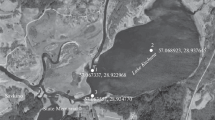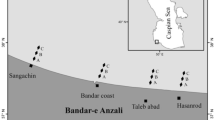Abstract
Based on the materials of summer phytoplankton studies in 2016–2018, an assessment of the ecological state of the Novosibirsk Reservoir is given. A total of 292 species and intraspecific taxa (SIT) from 8 divisions have been identified; the basis of the species richness is formed by diatoms and green algae. For the first time, 96 SIT have been found in the reservoir. The dominant phytoplankton complex and its changes in the interannual aspect along the longitudinal axis of the reservoir are characterized. The trophic status of the reservoir generally corresponds to the eutrophic category of water. An analysis of the structural indicators of phytoplankton and changes in the dominant complex in comparison with the end of the 20th century shows that the process of anthropogenic eutrophication is accelerating in the reservoir.

Similar content being viewed by others
REFERENCES
Antsiferova, G.A., Bioindication in geoecology: about eutrophication of interglacial, Holocene, and modern surface water ecosystems of the Upper Don basin, Vestn. Voronezh. Uiv., Ser. Geol., 2005, no. 1, p. 240.
Bazhenova, O.P., Fitoplankton Verkhnego i Srednego Irtysha v usloviyakh zaregulirovannogo stoka (Phytoplankton of the Upper and Middle Irtysh in Conditions of Regulated Flow), Omsk: Omsk. Gos. Agrarn. Univ., 2005.
Bazhenova, O.P. and Gulchenko, Ya.I., Long-term succession of the phytoplankton of the Irtysh River middle flow (Omsk, Russia), Int. J. Algae, 2017, vol. 19, no. 1, p. 85. https://doi.org/10.1615/InterJAlgae.v19.il.80
El’yashev, A.A., On a simple method of preparing a highly refractive medium for diatom analysis, Tr. Nauchno-Issled. Inst. Geol. Arkt., 1957¸ no. 4, p. 74.
Ermolaeva, N.I., Zarubina, E.Y., Bazhenova, O.P., et al., Influence of abiotic and trophic factors on the daily horizontal migration of zooplankton in the littoral zone of the Novosibirsk Reservoir, Inland Water Biol., 2019, vol. 12, no. 4, p. 418. https://doi.org/10.1134/S1995082919030052
Fedorov, V.D. and Kapkov, V.I., Rukovodstvo po gidrobiologicheskomu kontrolyu kachestva prirodnykh vod (Guidelines for Hydrobiological Control of Natural Water Quality), Moscow: Khristianskoe Izd., 2000.
Genkal, S.I. and Levadnaya, G.D., New data on the flora of diatoms of the Ob River, Nov. Sist. Nizshikh Rast., 1980, p. 3.
Genkal, S.I. and Romanov, R.E., Centric diatoms (Centrophyceae, Bacillariophyta) in watercourses and bodies of water in southeast of West Siberian Plain and Polar Ural, Contemp. Probl. Ecol., 2012, vol. 5, no. 4, p. 399.
Gol’d, Z.G., Muchkina, E.Ya., Grabovenko, I.S., et al., Dynamics of the state of the ecosystem of a deep-water reservoir under conditions of progressive anthropogenic impact (as exemplified by the Krasnoyarsk Reservoir), in Materialy nauchykh chtenii, posvyashchennykh pamyati prof. B.G. Ioganzena “Sostoyanie vodnykh ekosistem Sibiri i perspektivy ikh ispol’zovaniya” (Proc. Sci. Readings Dedicated to the Memory of Professor B.G. Ioganzen “State of Aquatic Ecosystems in Siberia and Prospects for Their Use”), Tomsk: Del’taplan, 1998, p. 320.
Gorbulin, O.S., Complexes of dominant forms of phytoplankton of different types of water bodies, Algologiya, 2012, no. 3, p. 303.
Guiry, M.D. and Guiry, G.M., AlgaeBase, World-wide electronic publication, National University of Ireland, Galway, 2020. http://www.algaebase.org. Accessed February 20, 2021.
Kirillov, V.V. and Chaikovskaya, T.S., Pigment characteristics of phytoplankton of the Novosibirsk Reservoir, in Kompleksnye issledovaniya Novosibirskogo vodokhranilischa (Comprehensive Studies of the Novosibirsk Reservoir), Moscow: Gidrometeoizdat, 1985, p. 84.
Kirillova, T.V. and Kotovschikov, A.V., Plant pigments as indicators of the environmental state of the Novosibirsk Reservoir, Mir Nauki, Kul’t., Obraz., 2009, no. 1, p. 26.
Kitaev, S.P., Osnovy limnologii dlya gidrobiologov i ikhtiologov (Fundamentals of Limnology for Hydrobiologists and Ichthyologists), Petrozavodsk: Karel. Nauchn. Tsentr Ross. Akad. Nauk, 2007.
Kol’tsova, T.I., Determination of the volume and surface of phytoplankton, Nauchn. Dokl. Vyssh. Shk., Ser. Biol., 1970, no. 6, p. 114.
Korneva, L.G., Formation of phytoplankton in water bodies of the Volga River basin under the influence of natural and anthropogenic factors, Extended Abstract of Doctoral (Biol.) Dissertation, St. Petersburg, 2009.
Korneva, L.G., Biological consequences of eutrophication, in Ekologichesky monitoring (Environmental Monitoring), part VIII: Sovremennye problemy monitoringa presnovodnykh ekosistem (Modern Problems of Monitoring of Freshwater Ecosystems), Rozenberg, G.S., et al., Eds., Nizhny Novgorod: Nizhegorod. Gos. Univ., 2014, p. 113.
Korneva, L.G., Fitoplankton vodokhranilisch basseyna Volgi (Phytoplankton of Reservoirs in the Volga River Basin), Kostroma: Kostrom. Pechatn. Dom, 2015.
Korneva, L.G. and Gluschenko, G.Yu., Composition and seasonal succession of phytoplankton of Taganrog Bay in the Sea of Azov and the downstream reaches of the Don River under a changing climate, Inland Water Biol., 2020, vol. 13, no. 1, p. 23. https://doi.org/10.1134/S1995082920010071
Kotovschikov, A.V. and Yanygina, L.V., Spatial heterogeneity of chlorophyll a content in the Novosibirsk Reservoir, Izv. Altai. Otd. Russ. Geogr. O-va, 2018, no. 3, p. 46.
Kozhevnikova, N.A., Species structure of phytoplankton of the Krasnoyarsk Reservoir (1977–2000), in Vserossiiskaya konferentsiya “Sovremennye problemy gidrobiologii Sibiri,” Tezisy dokladov (All-Russia Conf. “Modern Problems of Hydrobiology of Siberia,” Abstracts of Papers), Tomsk, 2001, p. 48.
Kozhova, O.M., Formation of phytoplankton of the Bratsk Reservoir, in Formirovanie prirodnykh uslovy i zhizni Bratskogo vodokhranilischa (Formation of Natural Conditions and Life of the Bratsk Reservoir), Moscow: Nauka, 1970, p. 26.
Kozhova, O.M. and Basharova, N. I., Produktivnost’ angarskikh vodokhranilisch, in Biologicheskie resursy vnutrennikh vodoemov Sibiri i Dal’nego Vostoka (Biological Resources of Inland Water Bodies of Siberia and the Far East), Moscow: Nauka, 1984, p. 175.
Krakhmal’nyi, A.F., Dinofitovye vodorosli Ukrainy (illyustrirovanny opredelitel’) (Dinophytic Algae of Ukraine (An Illustrated Identification Guide)), Kiev: Al’terpress, 2011.
Kuksn, M.S., Phytoplankton of the Novosibirsk Reservoir and its formation, Extended Abstract of Cand. Sci. (Biol.) Dissertation, Novosibirsk, 1965.
Kuksn, M.S. and Chaykovskaya, T.S., Interannual fluctuations in the species composition and biomass of phytoplankton in the Novosibirsk Reservoir, in Kompleksnye issledovaniya Novosibirskogo vodokhranilischa (Comprehensive Studies of the Novosibirsk Reservoir), Moscow: Gidrometeoizdat, 1985, p. 76.
Kuksn, M.S., Levadnaya, G.D., Popova, T.G., et al., Algae of the Ob River and its floodplain, in Vodorosli i griby Sibiri i Dal’nego Vostoka (Algae and Fungi of Siberia and the Far East), Novosibirsk: Nauka, 1972, part 2 (4), p. 3.
Lakin, G.F., Biometriya (Biometry), Moscow: Vysshaya shkola, 1990.
Magurran, A., Ecological Diversity and Its Measurement, Princeton: Princeton Univ. Press, 1983.
Makarevich, V.N., Dutch methods of accounting for the abundance of species according to de Vries in comparison with other methods for determination of species involvement in meadow herbage, Bot. Zh., 1966, no. 2, p. 293.
Metodika izucheniya biogeotsenozov vnutrennikh vodoemov (Methodology of Research of Biogeocenoses of Inland Water Bodies), Moscow: Nauka, 1975.
Mikhailov, V.V. and Bazhenova, O.P., Assessment of the water quality of the Novosibirsk Reservoir in terms of phytoplankton development, its abundance, and distribution features, Vestn. Orenburg. Gos. Pedagog. Univ., 2019¸ no. 1 (29), p. 11. https://doi.org/10.32516/2303-9922.2019.29.2S
Mikheeva, T.M., The structure and functioning of phytoplankton during water eutrophication, Extended Abstract of Doctoral (Biol.) Dissertation, Minsk, 1992.
Mnogoletnyaya dinamika vodno-ekologicheskogo rezhima Novosibirskogo vodokhranilischa (Long-Term Dynamics of the Water and Ecological Regime of the Novosibirsk Reservoir), Novosibirsk: Sib. Otd. Ross. Akad. Nauk, 2014.
Naumenko, Yu.V., Vodorosli fitoplanktona reki Obi (Algae of Phytoplankton of the Ob River), Novosibirsk: Preprint, 1995.
Okhapkin, A.G., The structure and succession of phytoplankton during regulation of river flow (as exemplified by the Volga River and its tributaries), Extended Abstract of Doctoral (Biol.) Dissertation, St. Petersburg, 1997.
Oksiyuk, O.P., Zhukinsky, V.N., Braginsky, P.N., et al., Complex ecological classification of the quality of land surface waters, Gidrobiol. Zh., 1993, vol. 29, no. 4, p. 62.
Puzachenko, Yu.G., Matematicheskie metody v ekologicheskikh i geograficheskikh issledovaniyakh (Mathematical Methods in Environmental and Geographic Research), Moscow: Academia, 2004.
Puzanov, A.V., Bezmaternykh, D.M., Vinokurov, Yu.I., et al., The current state of water resources and water management complex of the Ob-Irtysh basin, Trudy III Vserossyskoi nauchnoi konferentsii s mezhdunarodnym uchastiem “Vodnye i ekologicheskie problemy Sibiri i Tsentral’noi Azii” (Proc. III All-Russia Sci. Conf. with International Participation “Water and Environmental Problems of Siberia and Central Asia”), Barnaul: Pyat’ Plyus, 2017, vol. 1, p. 3.
Rossolimo, L.L., Antropogennoe evtrofirovanie vodoemov (Anthropogenic Eutrophication of Water Bodies), Itogi Nauki Tekhn., Obshch. Ekol. Biogeotsenol. Gidrobiol., vol. 2, Moscow: VINITI, Akad. Nauk SSSR, 1975, p. 8.
Sadchikov, A.P., Metody izucheniya presnovodnogo fitoplanktona: metodicheskoe rukovodstvo (Methods for Studying Freshwater Phytoplankton: Guidelines), Moscow: Universitet i Shkola, 2003.
Savkin, V.M. and Dvurechenskaya, S.Ya., Impact of long-term integrated use of water resources on the ecosystem of the Novosibirsk Reservoir, Voda Ekol.: Probl. Reshen., 2018, no. 1, p. 71.
Savkin, V.M., Dvurechenskaya, S.Ya., and Kondakova, O.V., Facets of hydrology in the modern use of the Upper Ob River flow, in Tret’i Vinogradovskie chteniya. Grani gidrologii: Sbornik dokladov mezhdunarodnoy nauchnoy konferentsii pamyati Yu.B. Vinogradova, 28–30 marta 2018 g. (Third Vinogradov Memorial Lectures “Facets of Hydrology,” Collection of Reports of the Int. Sci. Conf. in Memory of Yu.B. Vinogradov, March 28–30, 2018), St. Petersburg: Naukoemkie Tekhnologii, 2018, p. 781.
Suktsessii biotsenozov Bukhtarminskogo vodokhranilischa (Successions of Biocenoses of the Bukhtarma Reservoir), Omsk: Omsk. Gos. Agrarn. Uninv., 2009.
Timoshkin, O.A., Bondarenko, N.A., Volkova, E.A., et al., Mass development of green filamentous algae of the genera Spirogyra and Stigeoclonium (Chlorophyta) in the coastal zone of Southern Baikal, Gidrobiol. Zh., 2014, vol. 50, no. 5, p. 15.
Trifonova, I.S., Ekologiya i suktsessiya ozernogo fitoplanktona (Ecology and Succession of Lacustrine Phytoplankton), Leningrad: Nauka, 1990.
Voloshko, L.N., Zolotistye vodorosli vodoemov Severa Rossii (Chrysophyta of Water Bodies of the North of Russia), St. Petersburg: Renome, 2017.
Vorob’eva, S.S., Fitoplankton vodoemov Angary (Phytoplankton of Water Bodies of the Angara River), Novosibirsk: Nauka, 1995.
Funding
This work was carried out as part of a project of the Institute for Water and Environmental Problems, Siberian Branch, Russian Academy of Sciences (“Spatiotemporal Organization of Aquatic Ecosystems and Assessment of the Influence of Natural and Anthropogenic Factors on the Formation of Hydrobiocenoses and the Quality of Surface Waters in the Ob and Ob-Irtysh Interfluves)”.
Author information
Authors and Affiliations
Corresponding author
Ethics declarations
Conflict of interests. The authors declare that they have no conflicts of interest.
Statement on the welfare of humans or animals. This article does not contain any studies involving humans or animals performed by any of the authors.
Additional information
Translated by V. Mittova
Abbreviations: SIT, species and intraspecific taxa; DF, dominance frequency; pF, occurrence frequency; and Dt, dominance order
Rights and permissions
About this article
Cite this article
Bazhenova, O.P., Mikhailov, V.V. Phytoplankton As an Indicator of the Modern Ecological State of the Novosibirsk Reservoir. Inland Water Biol 14, 670–678 (2021). https://doi.org/10.1134/S1995082921050023
Received:
Revised:
Accepted:
Published:
Issue Date:
DOI: https://doi.org/10.1134/S1995082921050023




